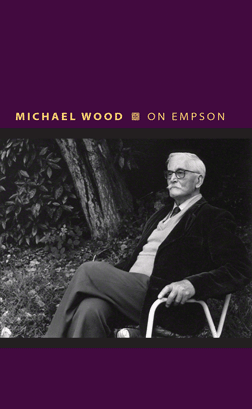On Empson
by Michael Wood
reviewed by Yun Ni
“Literary critics do not currently live, as many have supposed, in a post-theory world … as once fashionable names fade and mere practice continues, that which is interesting in theory will be even more interesting in the particular case.”
Thus does Michael Wood challenge the notion of a bright line between pre- and post-theory worlds of literary criticism. If Wood is right, one wonders how this affects the understanding of literary critics who have heretofore been relegated to particular slots along that supposed trajectory. What, for instance, are we to make of William Empson’s work in this context? In his recently published study, On Empson, Wood brings into question the widespread conception of a linear progression in literary studies from “conservative” close reading to high literary theory and then to post-theory, and proceeds to show how Empson defies categorization. True, he pioneered New Criticism, but Wood refuses to confine Empson to this small role.
Wood demonstrates how an Empsonian “centrality of language,” with a focus on contradictions, paradoxes, and lurking metaphors, animates and straddles both New Criticism and the consecutive critical schools, “including the ones he [Empson] detested.” However, this spirited introduction to Empson is more than a thoughtful reflection on the discipline’s history or a handbook on the duty of the literary critic. Wood considers as well Empson’s encounter with the East, devoting ample space to a discussion of Empson’s time in Japan and China during the 1930s and 40s, where his celebrated legacy still informs the practice of literary criticism today. Wood’s Empson engages with Buddhism in a way informed by Christian theology, “describing what he scarcely knows in a language he knows very well,” while still keeping Eurocentrism at bay.
The book follows a conceptual arc ranging from language philosophy to high theology. For example, the first chapter situates Empson in the Western literary tradition and elaborates how his preference for paradoxes and contradictions in language anticipates structuralism (with its interest in language as it pertains to the structure) and deconstruction (in which recurring lapses of meaning promise endless interpretation). Wood adopts an Empsonian voice in chapter three, “Large Dreams,” in which he offers a close reading of Empson’s three poems on an old lady, a secular theology embodied in a spider, and Wittgenstein’s language philosophy. “Sibylline Leaves” tackles the mystical, the Freudian, and the superstitious, and “The Smoke of Hell” reads myths into the theology of Empson’s Milton’s God and Faustus and the Censor.
Wood matches his subject in critical dexterity and patience. He is adept in identifying the sources of Empson’s loaded references. In “Arachne,” for instance, “Ovid hovers somewhere here as a source, even if he is almost immediately driven off by medieval theology.” In “To an Old Lady,” the last phrase of the poem, “cunningly adapted from Milton and Pope, … pulls us away from any straightforward identification.” Moreover, Wood’s theoretical attention never distracts or overshadows the formal analysis central to New Criticism.
Poetry and belief are the central concerns of Empson’s criticism, as is apparent in his encounter with the East. The asymmetrical sculpted faces of Buddha suggest “a tranquil fashioning of his seventh type” of ambiguity for Empson. A smile that prevents a smile, the high soaring eyebrows against the long slit eyes, and two uneven sides of the face produce opposing affective qualities. For Empson, they embody the ideas of an awakened sage both looking inside and looking upward, a self and a non-self, caught in a moment suggestive of abandoning the world while still being inside it. For Wood, this is not “Eurocentrism going wild,” but a dialectic of the transcendent and immanent that bridges the East and the West. Empson’s reading of Buddhism is essentially against a personified God in Christianity, whom Milton fails to justify and from whom Marlowe protects his Faustus.
Wood aligns the classic Humpty-Dumpty question from Lewis Carroll’s Through The Looking Glass—can we make words mean different things?—with Wittgenstein’s argument—whatever we see could be other than it is—which is Empson’s all-time favorite. The answers are not provided, but the critic’s duty is to offer room for alternative reactions: “Show us what there is to be looked at, prove there is a crossroads where we so far have seen only a single, well-trodden track.” Both Empson and Wood lead us to the crossroads, where they have hacked out several paths to be trodden and point out possible ways forward in the wilderness.
Published on October 5, 2017

